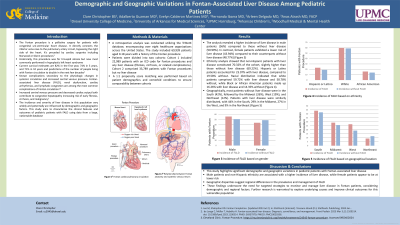Sunday Poster Session
Category: Pediatrics
P1469 - Demographic and Geographic Variations in Fontan-Associated Liver Disease Among Pediatric Patients: A Nationwide Analysis
Sunday, October 27, 2024
3:30 PM - 7:00 PM ET
Location: Exhibit Hall E

Has Audio

Clare Christopher, BS
Drexel University College of Medicine
Harrisburg, PA
Presenting Author(s)
Clare Christopher, BS1, Fernanda Ibarra, MD2, Adalberto Guzman, MD3, Evelyn Calderon Martinez, MD4, Diana Gavilanes, MD4, Arleen Delgado, MD5, Shane Tripp, MS1, Anas Atras, MD4
1Drexel University College of Medicine, Harrisburg, PA; 2Arkansas Children's Hospital, Little Rock, PA; 3University of Arkansas for Medical Sciences, Harrisburg, PA; 4UPMC Central PA, Harrisburg, PA; 5NYC Health + Hospitals/ Woodhull Medical Center, Brooklyn, NY
Introduction: The Fontan procedure is a palliative surgery for patients with congenital uni-ventricular heart function of which diverts deoxygenated blood from the body directly to the pulmonary artery circuit. There are known complications from the physiologic change in systemic circulation including Fontan-associated liver disease (FALD), renal dysfunction, and cardiac arrhythmias. The incidence and severity of liver disease vary, potentially influenced by demographic and geographic factors. This study aims to characterize the clinical features and outcomes of pediatric patients with FALD.
Methods: A retrospective analysis was conducted utilizing the TriNetX database. The study included 69,939 patients aged 0-18 years with a history of the Fontan procedure divided into two cohorts: Cohort 1 had 22,989 patients with ICD codes for Fontan procedures and liver disease (fibrosis, cirrhosis, or related complications). Cohort 2 had 33,789 patients with Fontan procedures but no FALD. A 1:1 propensity score matching was performed based on patient demographics and comorbid conditions.
Results: The analysis revealed a higher incidence of FALD in males (56%) compared to those without (50.99%). In contrast, females had a lower risk of liver disease (43.94%) compared to their counterparts without liver disease (48.77%). The analysis showed that non-Hispanic patients with liver disease constituted 70.32% of the cohort, slightly higher than those without liver disease (69.22%). Hispanic or Latino patients accounted for 23.07% with liver disease and 19.58% without. Racial distribution indicated that white patients comprised 59.72% with liver disease and 58.78% without, while Black or African American patients made up 16.26% with FALD and 14.35% without. Geographically, patients with FALD were distributed with 44% in the South, 29% in the Midwest, 27% in the West, and 9% in the Northeast. Patients without liver disease were in the South (42%), followed by the Midwest (26%), West (19%), and Northeast (12%).
Discussion: This study highlights demographic and geographic variations in pediatric patients with FALD. Male patients and non-Hispanic ethnicity are associated with a higher incidence of liver disease. Geographic disparities suggest regional differences in the prevalence and management of FALD. These findings underscore the need for targeted strategies to monitor and manage FALD, considering demographic and geographic factors. Further research is warranted to explore underlying causes and improve clinical outcomes.
Disclosures:
Clare Christopher, BS1, Fernanda Ibarra, MD2, Adalberto Guzman, MD3, Evelyn Calderon Martinez, MD4, Diana Gavilanes, MD4, Arleen Delgado, MD5, Shane Tripp, MS1, Anas Atras, MD4. P1469 - Demographic and Geographic Variations in Fontan-Associated Liver Disease Among Pediatric Patients: A Nationwide Analysis, ACG 2024 Annual Scientific Meeting Abstracts. Philadelphia, PA: American College of Gastroenterology.
1Drexel University College of Medicine, Harrisburg, PA; 2Arkansas Children's Hospital, Little Rock, PA; 3University of Arkansas for Medical Sciences, Harrisburg, PA; 4UPMC Central PA, Harrisburg, PA; 5NYC Health + Hospitals/ Woodhull Medical Center, Brooklyn, NY
Introduction: The Fontan procedure is a palliative surgery for patients with congenital uni-ventricular heart function of which diverts deoxygenated blood from the body directly to the pulmonary artery circuit. There are known complications from the physiologic change in systemic circulation including Fontan-associated liver disease (FALD), renal dysfunction, and cardiac arrhythmias. The incidence and severity of liver disease vary, potentially influenced by demographic and geographic factors. This study aims to characterize the clinical features and outcomes of pediatric patients with FALD.
Methods: A retrospective analysis was conducted utilizing the TriNetX database. The study included 69,939 patients aged 0-18 years with a history of the Fontan procedure divided into two cohorts: Cohort 1 had 22,989 patients with ICD codes for Fontan procedures and liver disease (fibrosis, cirrhosis, or related complications). Cohort 2 had 33,789 patients with Fontan procedures but no FALD. A 1:1 propensity score matching was performed based on patient demographics and comorbid conditions.
Results: The analysis revealed a higher incidence of FALD in males (56%) compared to those without (50.99%). In contrast, females had a lower risk of liver disease (43.94%) compared to their counterparts without liver disease (48.77%). The analysis showed that non-Hispanic patients with liver disease constituted 70.32% of the cohort, slightly higher than those without liver disease (69.22%). Hispanic or Latino patients accounted for 23.07% with liver disease and 19.58% without. Racial distribution indicated that white patients comprised 59.72% with liver disease and 58.78% without, while Black or African American patients made up 16.26% with FALD and 14.35% without. Geographically, patients with FALD were distributed with 44% in the South, 29% in the Midwest, 27% in the West, and 9% in the Northeast. Patients without liver disease were in the South (42%), followed by the Midwest (26%), West (19%), and Northeast (12%).
Discussion: This study highlights demographic and geographic variations in pediatric patients with FALD. Male patients and non-Hispanic ethnicity are associated with a higher incidence of liver disease. Geographic disparities suggest regional differences in the prevalence and management of FALD. These findings underscore the need for targeted strategies to monitor and manage FALD, considering demographic and geographic factors. Further research is warranted to explore underlying causes and improve clinical outcomes.
Disclosures:
Clare Christopher indicated no relevant financial relationships.
Fernanda Ibarra indicated no relevant financial relationships.
Adalberto Guzman indicated no relevant financial relationships.
Evelyn Calderon Martinez indicated no relevant financial relationships.
Diana Gavilanes indicated no relevant financial relationships.
Arleen Delgado indicated no relevant financial relationships.
Shane Tripp indicated no relevant financial relationships.
Anas Atras indicated no relevant financial relationships.
Clare Christopher, BS1, Fernanda Ibarra, MD2, Adalberto Guzman, MD3, Evelyn Calderon Martinez, MD4, Diana Gavilanes, MD4, Arleen Delgado, MD5, Shane Tripp, MS1, Anas Atras, MD4. P1469 - Demographic and Geographic Variations in Fontan-Associated Liver Disease Among Pediatric Patients: A Nationwide Analysis, ACG 2024 Annual Scientific Meeting Abstracts. Philadelphia, PA: American College of Gastroenterology.
